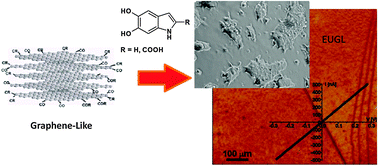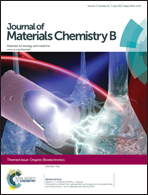Supplementing π-systems: eumelanin and graphene-like integration towards highly conductive materials for the mammalian cell culture bio-interface†
Abstract
Organic (bio)electronics appears to be the first target for competitive exploitation in the materials science of eumelanins, black insoluble photoprotective human biopolymers. Nonetheless, the low conductivity of these pigments is limiting the implementation of eumelanin-based devices. Here we present a novel organic/organic hybrid material (EUGL) by integration of conductive graphene-like (GL) layers within the EUmelanin pigment (EU). GL layers were obtained by a two-step oxidation/reduction of carbon black. The stability of GL layers over a wide pH range and the self-assembling tendency place this material in a leading position for the fabrication of hybrid materials in aqueous media. EUGL was obtained by inducing the polymerization of eumelanin precursors (5,6-dihydroxyindole, DHI and 5,6-dihydroxyindole-2 carboxylic acid, DHICA) in aqueous media containing GL layers. The new material featured promising biocompatibility and an increased conductivity with respect to eumelanin by four orders of magnitude.

- This article is part of the themed collection: Bioelectronics

 Please wait while we load your content...
Please wait while we load your content...